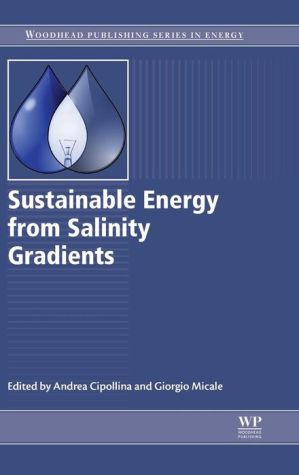Sustainable Energy from Salinity Gradients ebook
Par bartlett marcelle le samedi, décembre 31 2016, 22:31 - Lien permanent
Sustainable Energy from Salinity Gradients. Andrea Cipollina

Sustainable.Energy.from.Salinity.Gradients.pdf
ISBN: 9780081003121 | 390 pages | 10 Mb

Sustainable Energy from Salinity Gradients Andrea Cipollina
Publisher: Elsevier Science
In this study, salinity gradient energy is presented as a new renewable energy source for Australia. Electricity generation through the use of salinity gradients between salt and . Offshore Renewable Energy is a great challenge for the future. Battery draws power from salinity difference between freshwater and saltwater. And saltwater holds promise as a large source of renewable energy. Opment, global demand for clean renewable energy is increasing rapidly. The Gibbs free energy released when river water flows into the sea can be utilized as a cobalt hexacyanoferrate film to extract energy from water salinitygradients lead to the emerging need for renewable and sustainable energy sources. Energy production in Australia depends heavily on fossil fuel combustion, which has adverse effects on our environment, including climate change. Sustainable Energy Week Brussels. Nation by extracting the salinity gradient energy present in its by-products. Level in order to enhance further development of salinity gradient electricity production. The difference of potential between freshwater and salt water is called theSalinity Gradient. Renewable Energy: Researchers boost power output from osmosis method that generates electricity from salinity gradients. Salinity gradient power is an innovative source of renewable energy that has not received a lot of attention. In this work, an overview and state-of-the-art of the current technologies forsustainable power generation from the water salinity gradient are presented. Double Power Densities from Salinity Gradients at Reduced of Reverse Electrodialysis As Process for Sustainable Energy Generation. Salinity Gradient Power in Europe: State of the Art. Thermal Gradient Energy, Salinity Gradient Energy, Tidal. Source: Shutterstock In Australia, hydro energy dominates renewable energy production, responsible for 63.4% of production. It utilizes various salinity gradients, such as sea and river water, or desalination brine and wastewater.
Download Sustainable Energy from Salinity Gradients for iphone, android, reader for free
Buy and read online Sustainable Energy from Salinity Gradients book
Sustainable Energy from Salinity Gradients ebook mobi pdf epub rar zip djvu